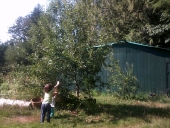




 1
1




 1
1




 1
1




 1
1








Danny Carm wrote:Have you though about grafting some kind of good-for-eating apple onto it? I'm not very knowledgable about grafting but maybe a bark graft would work?
Or if you don't want to graft onto it, you can at least use it for clonal rootstock. Cut the tree in the winter (might be too late already depending on where you live) and then when it warms up, lots of little shoots of nice, straight wood will grow from around the trunk. From my understanding, growing clonal rootstock is just like coppicing. And then you dig up the shoots later on for use as rootstock.
Johnny Niamert wrote:I cut down a silver maple and built a compost pile on top of it. I left the pile there for a full year, then removed it and just left a layer of compost to plant clover in. The stump was dead after a year, but it wasn't anywhere near rotten enough to "plant into". Clover did fine and lived on the thin layer of compost/soil that made it through the summer. In time, it will rot and act similar/the same as buried wood.
I would recommend similar. Build a big pile to compost over the stump and plant next to it.
I'm considering removing a crab apple also, as you, to free up space for productive tree plantings. I had not thought there would be much need to do more than just remove the stump to ground level, using hand tools. Alternatively, I could dig enough of an excavation around it to allow a chain saw to remove it to an inch or two, or more, below grade, then backfill. With the superstructure gone, would not the crabapple and sweetgum roots die and begin to rot? Could be a query for Dave Jacke following from his research into coppicing.
Assuming the workability of that approach, I would then just refrain from trying to establish any deep rooted plant directly above the buried former stump, or at the site of the stump exposed at grade. Considering that the stump is a structure that could have value for some useful or aesthetic function, one might be tempted to leave it protruding, since, if my initially proposed method is workable, only the actual physical space of the stump would have to be excluded from new planting, and the stump could play a new function in the garden, at least until it had rotted so far that it was no longer structurally sound.
I think I have read, in Permies.com, that only for the first year does decomposing wood, say above ground wood chips or buried wood, remove nitrogen, or but that may be wrong. I have had no trouble so far with planting into newly formed sheet-mulched beds topped with locally sourced "Ontario Blend" mulch--more shredded than chipped, and both deciduous and coniferous in origin.
I'll be interested in what more discussion shows.
i've planted a fig in a hugelkultur bed where the wood was so fresh it was still tying up nitrogen. just covered with about 6 inches of compost & a smidge of clay soil. the fig and cover crops did just fine, but nothing else seemed happy. i think it'd be worth covering the stump and planting, maybe not into it, but right beside it so there's room for the new trees roots to maneuver. might be wise to attack the top with a hatchet or drill some holes and slather the stump with a fungally dominated compost before covering it with soil and mulch. i've also used one of those products kevin talked about, then mulched really heavily and planted a tree directly next to the old stump and aside from having to take out a couple shoots from the old stump it worked pretty well. that shit is kind of weird tho, usually potassium nitrate but its hard to find a labelled product at box stores. i say go for it and we'll chock it up to experience. take notes!
...
Teaming With Microbes has a really simple method of creating fungal dominance in compost (great book, by the way, that belongs in everyones library). the gist is you take yer finished compost that should have loads of microscopic mycelia in there with all the bacteria and add some oats to feed the fungus. then you let them do their thing for a lil while before spreading or making compost tea. As far as the potassium nitrate goes, you drill a bunch of holes in the stump and pour it in, then add water to the holes. i don't really grok the chemical process, but it initiates a chemical decomposition process that takes about 6months to a year.
 2
2








Some people age like fine wine. I aged like milk … sour and chunky.

|
If you two don't stop this rough-housing somebody is going to end up crying. Sit down and read this tiny ad:
Learn Permaculture through a little hard work
https://wheaton-labs.com/bootcamp
|



